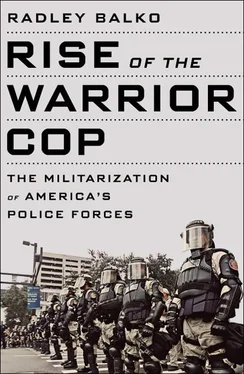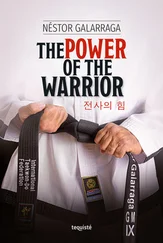Bollman made the journalists he had invited along promise to ask questions only of him or Kenny Krusco, the head of the federal team. But once Dickenson went down, photographer Ron Rose was able to freeze his death in one excruciating frame. Taken seconds after the shooting, Rose’s photo shows Dickenson lying on his right side, his left arm awkwardly draped over his body, his wrist facing up. His head is tilted back, and Clifton is kneeling next to him. Dickenson appears to be looking directly into his killer’s face. A uniformed deputy kneels on the other side of Dickenson, his eyes fixed on the dying man’s twitching leg. A rendition of the image would make the cover of Rolling Stone the following year.
Again to Arnold:
I kept asking how Dirk was and they wouldn’t tell me. The copter was back and they were taking Dirk away and I said—“Can I go with him?” They said, “No, you’d just be in the way.” One of the dogs, Boogie, was out there running around Dirk’s body. They were carrying Dirk onto the copter and Boogie was crying…. The copter took off and Boogie stood underneath it, looking up—the roar wasn’t scaring him at all now and he was howling. 58
The raid team had brought no medical personnel with them. That was odd, given that they had planned a major drug operation and indicated in the search warrant that they anticipated weapons. By the time word got back to the house that Dickenson needed a doctor, the helicopter had already departed for the base. The narcotics agents had to call it back over the radio to return to pick up the wounded man. The same helicopter that had just delivered the men who killed Dirk Dickenson then flew him to a hospital in a bid to save him. He was dead before it landed.
The police searched the house top to bottom. They found a joint, two roaches, several buttons of peyote, two LSD tablets, and a few small baggies of marijuana. No drug lab. They searched the surrounding area for hours. Some agents spent the night and searched more the next day. They didn’t find it. Arnold was arrested and jailed for the small quantities of pot, LSD, and peyote. Dickenson’s mother found out about her son’s death over the radio.
After several hours in the Eureka jail, Arnold said, one of the attendants called her out of her cell.
“He’s dead,” the attendant said. He then sent her back to her cell.
The Sheriff’s Department and federal agents quickly went into ass-covering mode. Undersheriff Bollman told the press, “You can’t blame officers for being uptight. They’re aware of the situation today. Officers don’t go out on duty thinking they’re going to shoot someone, but many times they may wonder if they’re going to return home that night.”
Three days after the raid, agent William Filben claimed he had tripped shortly after exiting the helicopter. The only people who saw him fall were Bollman, the local raid team leader, Krusco, leader of the federal team, and Clifton. The narrative went like this: Clifton thought Filben had been shot by someone in the house. That was why he kicked in the door and entered without knocking or announcing (they did not have a no-knock warrant). When Dickenson fled, Clifton, clad in jeans, boots, and a brown corduroy jacket, assumed he was the one who had shot Filben. When Dickenson then didn’t obey his command to stop, Clifton had no choice but to shoot him. As to why Clifton couldn’t have shot the fleeing, unarmed man in the leg, federal agent Ed McReedy replied, “The idea of shooting to wound is bush league.”
US Attorney James L. Browning promised an investigation. “We are attempting to be as impartial as possible,” he said. “We have an open mind.” Seconds later, he added, “Nevertheless, on the basis of incomplete reports received by this office, I suspect it will fall into the category of justifiable homicide.” He’d keep an open mind, but he had pretty much already made up his mind.
A month after the shooting, Humboldt County district attorney William Ferroggiaro went out to inspect the ranch and to re-create the scene for himself. While walking about two hundred feet from the house, he was stunned to find what looked to be a small drug lab. There was a tent, a platform, two containers of a chemical used to make PCP, a flask, and some broken glass lab equipment. It was far from a million-dollar operation. It was also far from plausible. Dozens of law enforcement officials had scoured the property for hours and found nothing. But now, visiting the site a month later, he easily found the allegedly incriminating evidence pointing to Dickenson’s drug operation. To his credit, Ferroggiaro reported the find—then publicly expressed his doubt about how it got there. “There’s a certain amount of taint to the discovery,” he said. “The possibility must be considered that the materials were planted on the Dickenson property subsequent to the initial search.”
A federal judge soon dismissed the charges against Judy Arnold, finding that Clifton violated her Fourth Amendment rights when he entered without announcing. The judge also reprimanded Clifton for his actions. But that would be about as much punishment as Clifton would get. In June, the BNDD came to a “preliminary conclusion” that “Clifton was justified in shooting.” At the end of November, nearly eight months after Dickenson’s death, US Attorney Browning announced that he too had determined that the shooting was justified and he wouldn’t be pressing charges.
That left Humboldt County and District Attorney Ferroggiaro. In recent years, Ferroggiaro had shown a willingness to go after the area’s bad cops. But few expected Ferroggiaro to take on the federal government. It was a surprise to nearly everyone when he did. According to Ezsterhas, Ferroggiaro was furious that someone had picked him to be the rube to find the fake PCP lab in the cover-up. The Justice Department had also been uncooperative with his investigation. After hearing about Clifton’s abusive track record from an investigator hired by Judy Arnold’s attorneys, Ferroggiaro had heard enough. He brought a second-degree murder charge against Clifton. A Humboldt County grand jury indicted the officer in January 1973. It was the first time a federal narcotics agent had ever been indicted for actions he’d taken while on the job. 59US Attorney Browning quickly pounced on the prosecutor, telling the Eureka newspaper that every other prosecutor he’d talked to said it was a “classical case of justifiable homicide.” The paper then reported, amusingly, that “Ferroggiaro’s response to Browning’s remarks is unprintable.” 60
By now the case had the attention of high-ranking Nixon administration officials, including US Attorney General Richard Kleindienst. Letting this local prosecutor get away with indicting a federal drug cop would set a troubling precedent. They couldn’t let this get to trial. Kleindienst’s office contacted James McKittrick, a local attorney who was known for defending cops accused of misconduct and who had battled (and beaten) Ferroggiaro in the past. McKittrick was flown to Washington, where Kleindienst then deputized him as a special US attorney. McKittrick wasted little time in needling Ferroggiaro. In February 1973, he wrote a letter to the editor of the Times-Standard explaining that people who question the actions of police are usually “radical elements” who want to “bring our country down.” Ferroggiaro had a history of questioning police. McKittrick insisted that he’d never suggest Ferroggiaro was part of these radical elements. Only that the radicals benefited every time Ferroggiaro brought a cop to trial. 61
McKittrick moved to get the charges dismissed. In so doing, he made two particularly ridiculous arguments. First, he argued that to allow the prosecution of Clifton to go forward would jeopardize an entire year’s worth of drug investigations on which Clifton had worked. This was the same variety of argument that defense attorneys would make at the trials of federal narcotics agents who had conducted mistaken raids in the coming years. But this one was troubling. At this point in the criminal process, no one was adjudicating Clifton’s guilt or innocence. Instead, McKittrick, now representing the federal government, was arguing that even if Clifton did murder Dirk Dickenson, the charge should be dismissed, because to try him would interfere with the government’s efforts to investigate other drug pushers.
Читать дальше












